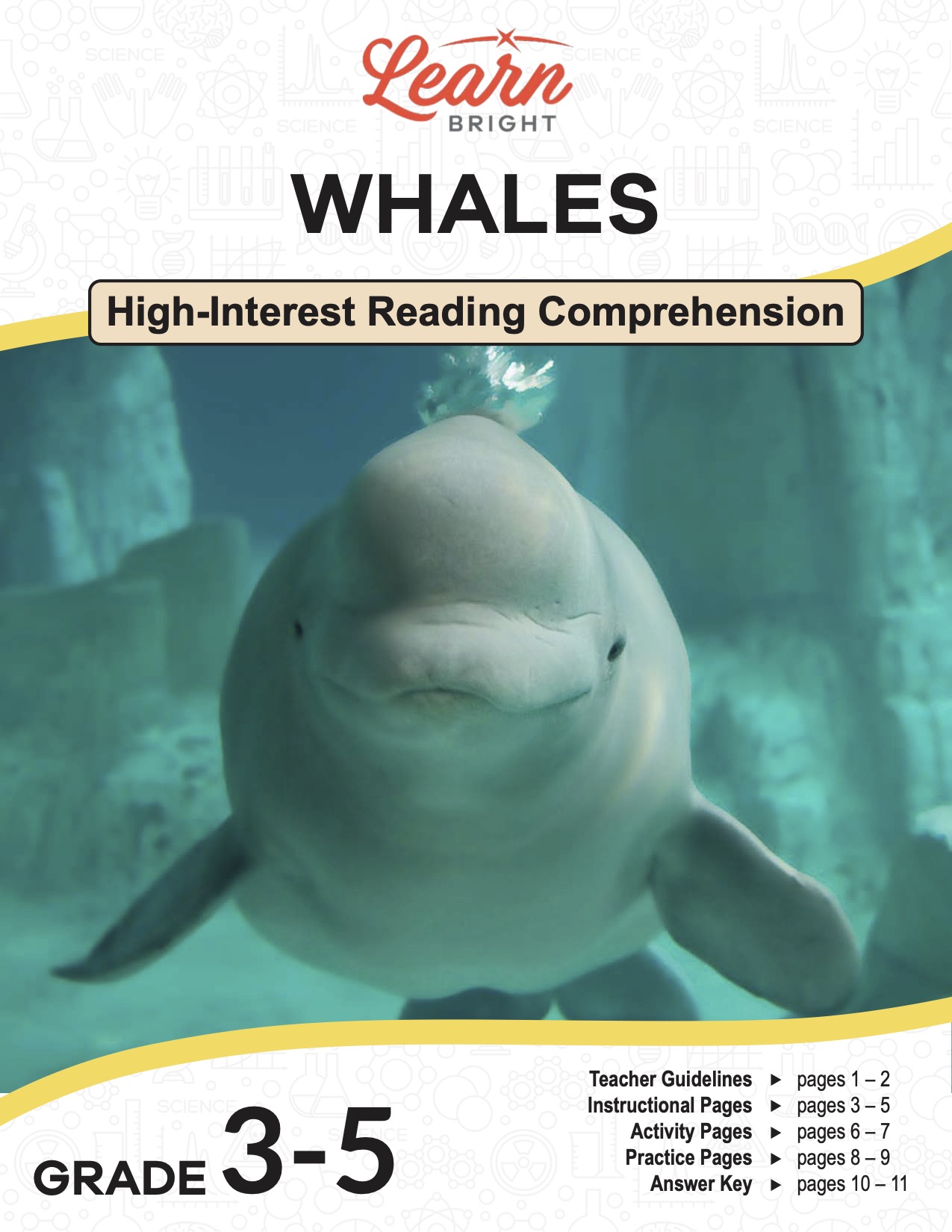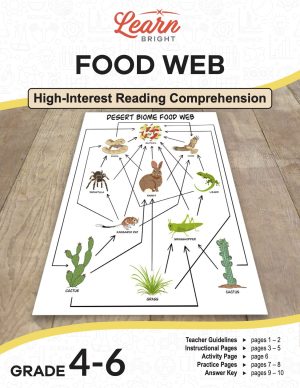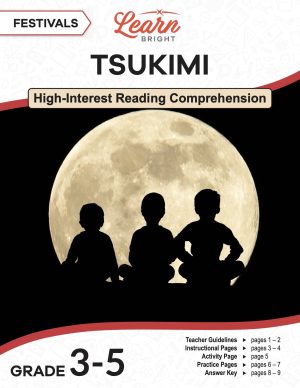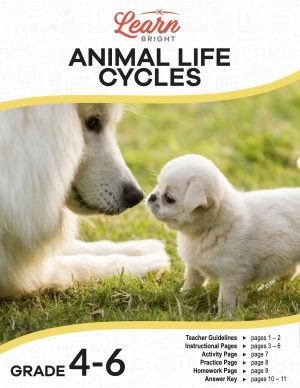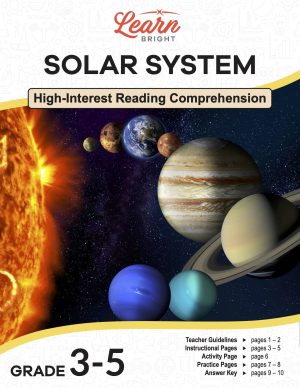Description
What our Whales lesson plan includes
Lesson Objectives and Overview: Whales is a high-interest reading comprehension lesson plan. As such, students will practice various close reading and comprehension skills. In addition, they will learn about the habitat, diet, and behaviors of whales. This lesson is for students in 3rd grade, 4th grade, and 5th grade.
Classroom Procedure
Every lesson plan provides you with a classroom procedure page that outlines a step-by-step guide to follow. You do not have to follow the guide exactly. The guide helps you organize the lesson and details when to hand out worksheets. It also lists information in the yellow box that you might find useful. You will find the lesson objectives, state standards, and number of class sessions the lesson should take to complete in this area. In addition, it describes the supplies you will need as well as what and how you need to prepare beforehand.
Teacher Notes
The teacher notes page provides an extra paragraph of information to help guide the lesson and remind you what to focus on. It explains that you can teach this lesson in a whole-class setting or as an independent, small-group activity. The blank lines on this page are available for you to write out thoughts and ideas you have as you prepare the lesson.
WHALES LESSON PLAN CONTENT PAGES
What Are Whales?
The Whales lesson plan contains three content pages. To start off, it provides a small box with basic background information about whales. These marine mammals live in every ocean. They are carnivores, so they only eat meat (fish). Believe it or not, scientists are not sure what the life span of a whale is.
Even though whales live in the water, they are mammals just like you and me. Humans and whales breathe air, have hair, are warm-blooded, give live births to their young, and feed their young milk. They are quite large—much bigger than humans. In fact, a whale’s size can range from 9 to 98 feet! Think of the length of a professional basketball court. And these massive mammals have quite the range in weight, too. They can be as small as the 600-pound dwarf sperm whale or weigh more than 200 tons, like the colossal blue whale. Imagine the average house (approximately 2,000 square feet), and you have some idea how heavy 200 tons is.
There are two types of whales: toothed and baleen. Toothed whales use their teeth for hunting and eating. This group includes sperm whales and orcas, as well as dolphins, porpoises, and narwhals. Speaking of narwhals, a narwhal’s horn is actually one long tooth protruding or sticking out through its lip! Baleen whales are larger than toothed whales and include blue whales, humpbacks, bowhead whales, and many others. They eat by straining creatures through the fringed plates of long, fingernail-like material called baleen.
Whale Diet
Toothed and baleen whales eat very differently. Toothed whales are grabbers and suckers while baleen whales are skimmers and gulpers. Toothed whales all have teeth. However, they differ in the number, size, and position of the teeth in their mouths. And from species to species, the teeth even have different purposes. For example, orcas use their teeth to grab food, but narwhals use their long tooth tusk to help them “taste” in the surrounding water.
While they all have teeth, toothed whales don’t use their teeth for chewing food. They do not have molars to grind up their food, so they swallow it whole or in large chunks. Toothed whales use echolocation to help them find and target their prey. They usually eat fish, squid, and octopus. But sometimes, orcas will also eat sharks or other marine mammals.
Baleen whales do not have teeth. Instead, they have hundreds of overlapping baleen plates growing downward from the gums of the upper jaw. Baleen is made out of keratin, the same thing our hair and fingernails are made of. Each whale species has a unique number, size, and color of baleen plates. Baleen is strong and flexible, making it the perfect colander or filter to strain out seawater and keep in prey.
Inside the baleen plates is a hairy fringe, which is how the whales earned the nickname “mysticete” or mustached whales. They swim through patches of plankton with their mouths open. Tiny plankton caught by the baleen remain trapped in their mouths. Grey whales suck amphipods like a vacuum cleaner from the bottom of the ocean. They take in mouthfuls of mud and food before forcing the water and mud out through their baleen to capture their prey.
Other Interesting Facts
Under water, whales are great communicators and make otherworldly noises that can be heard for miles. They have complex combinations of moans, howls, and cries that they produce when they push air around in their head. The sound of the air moving around is amplified through a blob of fat on the top of their jaw. People believe that whales communicate through these sounds.
The blue whale is the biggest whale alive today. Not only is it the biggest today, but it is the biggest creature to have ever lived on Earth. They are even larger than a brontosaurus (or any other dinosaur)! Because they live in the ocean, salt water supports their bodies, which helps them float. The females are larger than the males, and the blue whales in the Southern Hemisphere are larger than those in the Northern Hemisphere.
While the blue whale is an enormous creature, it doesn’t have the largest brain. The largest brain on Earth belongs to the sperm whale. Their brains are almost 500 cubic inches. That is five times the volume of our human brains, which are around 80 cubic inches! Sperm whale brains also weigh six times as much as a human brain. That means their brains weigh about 20 pounds!
Sperm whales can have such large brains because they have giant heads, up to a third of their overall body length. But their brain doesn’t take up most of the room. Instead, inside their head is a large cavity, or open space, filled with yellowish oil called spermaceti. This oil was valuable to whalers who sold it for lamp fuel, creams, and ointments.
Why They Are Important
Whales are at the top of the food chain and play an essential role in the health of the ocean ecosystem. Whale poop fertilizes microscopic phytoplankton, on which all sea life depends. In addition, phytoplankton help lessen climate change by capturing carbon and producing over half of the world’s oxygen. The relationship between whales, phytoplankton, and the atmosphere is essential to sustaining a healthy ocean and planet.
Students will learn that, for a long time, whales were hunted, and blue whales are now rare because of widespread commercial hunting. Other whale populations ended up on the verge of extinction, while others were entirely wiped out. Whale hunting has essentially stopped, but whales still face dangers. They often get caught in fishing nets, which can be very dangerous.
Large vessels supporting oil and gas have increased shipping in the ocean, creating a lot more noise. Unfortunately, this noise masks many whale communications and makes it difficult for whales to find food and mates. It also makes navigation and caring for their young much more difficult.
WHALES LESSON PLAN WORKSHEETS
The Whales lesson plan includes two worksheets: an activity worksheet and a practice worksheet. Each one will help students solidify their grasp of the material they learned throughout the lesson. You can refer to the classroom procedure guidelines to know when to hand out each worksheet.
SAVE THE WHALE ACTIVITY WORKSHEET
For the activity, students will read through a real naval officer report about the rescue of a female orca in central Puget Sound in Washington State. Then they will create a poster explaining why the whale should return to her pack and how humans can help. Students can use the box on the second activity page or use a separate sheet of paper.
WHALES PRACTICE WORKSHEET
The practice worksheet requires students to answer a series of 11 questions. These questions all relate to the content pages, so students will need to refer to them often for the answers. In addition, each question provides which reading tool the question corresponds to, such as text feature, vocabulary, or comprehension.
Worksheet Answer Keys
At the end of the lesson plan document is an answer key for the practice worksheet. The correct answers are all in red to make it easier for you to compare them with students’ responses. If you choose to administer the lesson pages to your students via PDF, you will need to save a new file that omits these pages. Otherwise, you can simply print out the applicable pages and keep these as reference for yourself when grading assignments.

